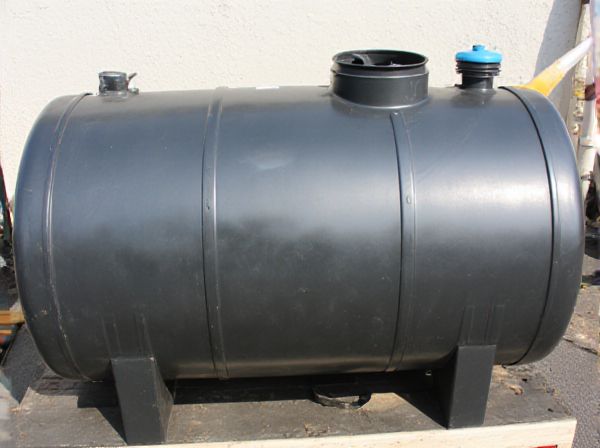
Photo illustration: Plastic Tank vs Steel Tank
Plastic tanks offer superior resistance to corrosion and are lightweight, making them easier to install and maintain compared to steel tanks. Steel tanks provide greater strength and durability, ideal for high-pressure applications and environments requiring enhanced impact resistance. Your choice depends on factors like budget, intended use, and environmental conditions, ensuring optimal performance and longevity.
Table of Comparison
| Feature | Plastic Fuel Tank | Steel Fuel Tank |
|---|---|---|
| Material | High-density polyethylene (HDPE) | Carbon steel or stainless steel |
| Weight | Lightweight, reduces vehicle weight | Heavier, adds vehicle weight |
| Corrosion Resistance | Highly corrosion-resistant | Susceptible to rust without coating |
| Durability | Impact-resistant but can crack under stress | Strong and durable, resists impact better |
| Manufacturing Cost | Lower manufacturing cost | Higher manufacturing and maintenance cost |
| Fuel Permeability | Some permeability to hydrocarbons | Minimal fuel permeability |
| Installation | Easier to mold into complex shapes for space optimization | Less flexible design options |
| Environmental Impact | Recyclable, but plastic waste concerns | Recyclable metal, longer life cycle |
Introduction to Plastic and Steel Tanks
Plastic tanks offer exceptional corrosion resistance and lightweight durability, making them ideal for storing chemicals and water in various industries. Steel tanks boast superior strength and high-temperature tolerance, preferred for industrial applications where structural integrity is critical. Understanding the material properties and environmental suitability of each tank type is essential for selecting the right storage solution.
Material Composition: Plastic vs Steel
Plastic tanks are composed primarily of polyethylene or polypropylene, offering corrosion resistance and lightweight properties ideal for chemical storage and outdoor use. Steel tanks consist of carbon steel or stainless steel, providing superior strength, durability, and temperature resistance for industrial applications. Material composition directly impacts tank longevity, maintenance requirements, and suitability for specific environments.
Durability and Lifespan Comparison
Plastic tanks offer high resistance to corrosion, chemicals, and UV exposure, enhancing their durability in various environments. Steel tanks provide superior structural strength and can withstand higher pressures but are prone to rust and corrosion without proper coatings or maintenance. On average, plastic tanks have a lifespan of 15-20 years, while steel tanks can last 20-30 years if adequately protected from environmental damage.
Corrosion and Chemical Resistance
Plastic tanks exhibit superior corrosion resistance compared to steel tanks, as they are inherently non-reactive to most chemicals and do not rust or degrade when exposed to moisture or acidic substances. Steel tanks require protective coatings or liners to prevent corrosion caused by exposure to water, chemicals, and oxygen, which can lead to costly maintenance and reduced lifespan. The chemical resistance of plastic tanks makes them ideal for storing aggressive substances, while steel tanks are more prone to corrosion-related failures unless carefully maintained.
Weight and Installation Ease
Plastic tanks weigh significantly less than steel tanks, offering enhanced portability and reduced shipping costs. Their lighter weight simplifies installation, often allowing one or two people to handle the tank without heavy machinery. Steel tanks require more robust support structures and specialized equipment for installation due to their considerable weight and rigidity.
Maintenance Requirements
Plastic tanks require minimal maintenance due to their resistance to corrosion, rust, and chemical reactions, making them ideal for storing various liquids without frequent inspections or repairs. Steel tanks demand regular maintenance, including rust prevention treatments, painting, and welding inspections to address corrosion and structural integrity issues. Proper upkeep of steel tanks is essential to prolong their lifespan and ensure safe storage, while plastic tanks offer cost-effective and low-maintenance alternatives in many industrial applications.
Cost Analysis: Initial and Long-Term
Plastic tanks generally offer lower initial costs compared to steel tanks due to cheaper raw materials and simpler manufacturing processes. Over the long-term, steel tanks often incur higher maintenance expenses because of corrosion risks, whereas plastic tanks require minimal upkeep and resist rust, lowering overall lifecycle costs. Cost analysis should consider factors such as durability, maintenance frequency, and replacement intervals to determine the most economical option for specific applications.
Environmental Impact and Sustainability
Plastic tanks offer advantages in environmental impact due to their lightweight nature, which reduces transportation emissions and energy consumption during manufacturing compared to steel tanks. They are often made from recyclable materials like high-density polyethylene (HDPE), enhancing sustainability through potential reuse and lower carbon footprints. However, steel tanks provide durability and longevity, contributing to sustainability by reducing the frequency of replacement and waste generation in industrial applications.
Common Applications and Industry Use
Plastic tanks are widely utilized in chemical processing, water treatment, and agricultural industries due to their resistance to corrosion and lightweight nature. Steel tanks dominate in petroleum storage, manufacturing, and fire protection systems because of their high strength and durability under extreme conditions. Each tank type aligns with specific industry standards, optimizing performance based on the stored substance's properties and operational demands.
Choosing the Right Tank for Your Needs
Plastic tanks offer excellent chemical resistance, affordability, and lightweight durability, making them ideal for storing corrosive liquids and in environments with minimal physical impact. Steel tanks provide superior strength, high-pressure resistance, and longer lifespan, suitable for heavy-duty industrial applications and outdoor settings exposed to extreme weather. Selecting the right tank depends on factors like the stored substance, environmental conditions, budget constraints, and required durability.
 caratoz.com
caratoz.com